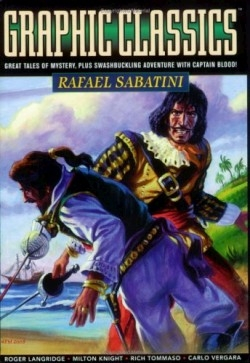Graphic Classics
Rafael Sabatini, Volume 13
Older readers and lovers of vintage movies will remember the swashbuckling adventures of Captain Blood, brought to life on the big screen by Errol Flynn. The memorable, larger-than-life character of Blood leads off this tribute volume to novelist and short story writer Sabatini, who wrote the Blood adventures and many more. Younger readers unfamiliar with such afternoons of adventure are in for a treat. In this collection, several artists and illustrators re-tell Sabatini’s stories in graphic novel form.
Sabatini himself is profiled in the piece “Desperately Seeking Sabatini,” which offers a brief biographical sketch of the man who penned so many of the historical adventure novels that served as the source for Captain Blood, Scaramouche, and other hit movies. An Italian expatriate living in England who chose to write in English “because all the best stories are in English,” Sabatini chose his subject matter because it was “more fun to write them than to read them.” Yet his personal life was scarred by tragedy. This short account is a great example of how graphic novels can, if done well, put across a tremendous amount of information in few pages and pictures, and do so with sensitivity and humor.
The editor has designed and produced Graphic Classics for ten years, in addition to working as a freelance graphic artist and computer graphics trainer. Here, in addition to the Captain Blood tales, he includes Sabatini’s “The Valet Mystery,” “The Spiritualist,” and “The Risen Dead,” which originally appeared as short stories in magazines. The artists’ styles vary widely in this volume, from the lush, gorgeous color front cover reminiscent of extravagant movie posters to the spare and economical drawings in “The Dream,” the elegant and detailed drawings of a bewigged, lace-at-collar-and-cuffs French detective-thief in “The Plague of Ghosts,” and the truly cartoonish style of “The Fool’s Love Story” (reminiscent in its human figures of Al Capp’s work) and the brightly colored back cover. Many of the artists rely heavily on the bold use of black, yet each does so in a different way to keep the eye moving from frame to frame.
Many of the tales are set in the England or France of generations past, and evoke the flavor of the period through subtle and not-so-subtle details—the cut of a jacket here (“The Dream”), a timbered cottage there (“The Risen Dead”). Faces and bodies likewise convey emotion and action through lines, posture, and shading.
The adaptations are short but effective, retaining the excitement and suspense of the originals, while the illustrations enhance the atmosphere—whether sinister and overbearing, introspective and thoughtful, or filled with action. Artists and adapters alike have done a fine job in translating Sabatini’s works yet again for a new audience. Lavish detail in one story gives way to simple settings in another, each telling its tale in its own way.
Reviewed by
Marlene Satter
Disclosure: This article is not an endorsement, but a review. The publisher of this book provided free copies of the book to have their book reviewed by a professional reviewer. No fee was paid by the publisher for this review. Foreword Reviews only recommends books that we love. Foreword Magazine, Inc. is disclosing this in accordance with the Federal Trade Commission’s 16 CFR, Part 255.

